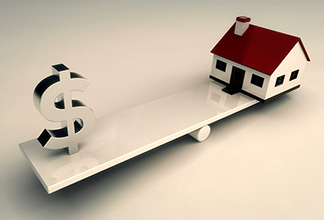Is Loss Aversion Hanging in Your Closet?
Written by Leigh Felesky
Published on April 8, 2017
minute read
Share:
Getting dressed this morning was easy. The hangers in the closet slid effortlessly, each piece of clothing was exactly where it should be, organized by colour and style, and in ready-to-wear condition. Recognize this feeling? If you do, take a moment to be proud!
Entire industries exist to help people get to this daily place of organizational nirvana. After all, closet chaos is easy to find. We collect so much over the years that editing and sorting becomes a challenge. Sometimes it seems impossible.
I always start out with the best intentions, but just as I'm on the verge of throwing something out I stop myself. I think, But wait…what if it comes back in style? Or, What if I lose 10 pounds and can actually fit into it again?
Second-guessing also happens with my investment portfolio at times. When considering whether to keep an underperforming stock, I might think, What if it makes a rebound and I can avoid taking a loss? Maybe I should hold on to it. Behavioural economists call this loss aversion.
What is Loss Aversion?
Loss aversion suggests that because losses are more powerful in our minds than gains, we tend to naturally avoid them. Here's how it works: If I told you I would be taking five random items out of your closet to give away, you'd likely panic at the thought of the loss. But if I told you I'd make it up to you by replacing those items with five new pieces from the designer of your choice, you'd likely be excited. Fast-forward a few months, however, and the traumatic memory of me taking your stuff away would outweigh the exhilaration of getting the new items. In general, your mind's overemphasis on loss compels you to sidestep it at all costs.
Why Does it Matter?
Both closets and investment portfolios can become cluttered and lack focus. Instead of cutting your losses on what's no longer working for you, you might hang on because of loss aversion.
I'll give you a somewhat irrational example. I often wear pants, but lately I've wanted to update my look by adding dresses. A well-made dress is easy to wear and always looks put together. This decision sounds great in theory, but it still presents a risk for a consummate pants-wearer like me. If a new dress doesn't fulfill the promise to look and feel amazing, I likely won't wear it. So in a sense, it could become a poor wardrobe performer, and I might regret my purchase. Plus, in order to make way for that new dress, I'd need to clear out space in my closet. Even though I've got numerous pairs of ill-fitting, uncomfortable pants that could be tossed to make room, I struggle to purge the trousers for fear of regretting the loss.
What Role Does Risk Play?
Fear, in part, can be responsible for a stagnating style. Have you ever bought a new shirt only to come home and find out that you have three others that look almost identical? Guilty. The same old look means avoiding the risk of uncertainty. At the same time, it keeps you from exploring new options.
I've realized that, like in my closet, loss aversion could be playing out in my portfolio. Most of us would agree that if we haven't worn something for a year or two — or it's not performing well — it might be time to objectively review the situation, cut your losses and move on. Loss and change are often necessary to make way for the new.
Preferring to avoid loss over enjoying gains can affect our decision making when it comes to investments, too. It may lead to delaying a portfolio cleanup, could contribute to a rash decision to sell all of our market investments if a significant decline happens, or might cause us to avoid equity markets entirely — which could mean missing out on investment growth.
"Loss and change are often necessary to make way for the new."
So how do you avoid loss aversion? Understanding your investment goals and what you need to get there can help.
Now whether I'm doing a closet clear-out or reviewing my investments, I've vowed to always ask myself: “Will tossing a poor wardrobe or portfolio performer create space that will be more valuable than keeping the status quo?" If the answer is yes, even if it means loss in some way, I know it could be time to make a change.
Does loss aversion affect you? Leave a comment* to share your thoughts.
This article was featured in our special issue, as seen in the Globe and Mail. Download the full magazine HERE.
*Comments only enabled for clients. Not a client? You can open and account or get a free practice account. If you are a client, sign in to read or comment.
**This article was updated on Feb. 7, 2020.
RBC Direct Investing Inc. and Royal Bank of Canada are separate corporate entities which are affiliated. RBC Direct Investing Inc. is a wholly owned subsidiary of Royal Bank of Canada and is a Member of the Investment Industry Regulatory Organization of Canada and the Canadian Investor Protection Fund. Royal Bank of Canada and certain of its issuers are related to RBC Direct Investing Inc. RBC Direct Investing Inc. does not provide investment advice or recommendations regarding the purchase or sale of any securities. Investors are responsible for their own investment decisions. RBC Direct Investing is a business name used by RBC Direct Investing Inc. ® / ™ Trademark(s) of Royal Bank of Canada. RBC and Royal Bank are registered trademarks of Royal Bank of Canada. Used under licence.
© Royal Bank of Canada 2020. All rights reserved.
The views and opinions expressed in this publication are for your general interest and do not necessarily reflect the views and opinions of RBC Direct Investing. Furthermore, the products, services and securities referred to in this publication are only available in Canada and other jurisdictions where they may be legally offered for sale. If you are not currently resident of Canada, you should not access the information available on the RBC Direct Investing website.
Explore More

Should I Invest or Pay Down My Mortgage?
Consider these four questions
minute read

As Many Head Back to the Office, Where Could Investors See Changes?
How returning to in-person work could affect a range of investments
minute read

Considering the FIRE Lifestyle? Here’s What Your Investments Might Look Like
We asked three people how they created financial independence and retired early
minute read
Inspired Investor brings you personal stories, timely information and expert insights to empower your investment decisions. Visit About Us to find out more.







